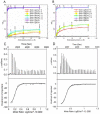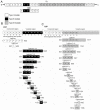The terminal immunoglobulin-like repeats of LigA and LigB of Leptospira enhance their binding to gelatin binding domain of fibronectin and host cells
- PMID: 20585579
- PMCID: PMC2892007
- DOI: 10.1371/journal.pone.0011301
The terminal immunoglobulin-like repeats of LigA and LigB of Leptospira enhance their binding to gelatin binding domain of fibronectin and host cells
Abstract
Leptospira spp. are pathogenic spirochetes that cause the zoonotic disease leptospirosis. Leptospiral immunoglobulin (Ig)-like protein B (LigB) contributes to the binding of Leptospira to extracellular matrix proteins such as fibronectin, fibrinogen, laminin, elastin, tropoelastin and collagen. A high-affinity Fn-binding region of LigB has been localized to LigBCen2, which contains the partial 11th and full 12th Ig-like repeats (LigBCen2R) and 47 amino acids of the non-repeat region (LigBCen2NR) of LigB. In this study, the gelatin binding domain of fibronectin was shown to interact with LigBCen2R (K(D) = 1.91+/-0.40 microM). Not only LigBCen2R but also other Ig-like domains of Lig proteins including LigAVar7'-8, LigAVar10, LigAVar11, LigAVar12, LigAVar13, LigBCen7'-8, and LigBCen9 bind to GBD. Interestingly, a large gain in affinity was achieved through an avidity effect, with the terminal domains, 13th (LigA) or 12th (LigB) Ig-like repeat of Lig protein (LigAVar7'-13 and LigBCen7'-12) enhancing binding affinity approximately 51 and 28 fold, respectively, compared to recombinant proteins without this terminal repeat. In addition, the inhibited effect on MDCKs cells can also be promoted by Lig proteins with terminal domains, but these two domains are not required for gelatin binding domain binding and cell adhesion. Interestingly, Lig proteins with the terminal domains could form compact structures with a round shape mediated by multidomain interaction. This is the first report about the interaction of gelatin binding domain of Fn and Lig proteins and provides an example of Lig-gelatin binding domain binding mediating bacterial-host interaction.
Conflict of interest statement
Figures






Similar articles
-
Repeated domains of leptospira immunoglobulin-like proteins interact with elastin and tropoelastin.J Biol Chem. 2009 Jul 17;284(29):19380-91. doi: 10.1074/jbc.M109.004531. Epub 2009 May 27. J Biol Chem. 2009. PMID: 19473986 Free PMC article.
-
Physiological osmotic induction of Leptospira interrogans adhesion: LigA and LigB bind extracellular matrix proteins and fibrinogen.Infect Immun. 2007 May;75(5):2441-50. doi: 10.1128/IAI.01635-06. Epub 2007 Feb 12. Infect Immun. 2007. PMID: 17296754 Free PMC article.
-
Leptospira immunoglobulin-like protein B (LigB) binding to the C-terminal fibrinogen αC domain inhibits fibrin clot formation, platelet adhesion and aggregation.Mol Microbiol. 2011 Feb;79(4):1063-76. doi: 10.1111/j.1365-2958.2010.07510.x. Epub 2011 Jan 10. Mol Microbiol. 2011. PMID: 21219469
-
Leptospiral Immunoglobulin-Like Domain Proteins: Roles in Virulence and Immunity.Front Immunol. 2021 Jan 8;11:579907. doi: 10.3389/fimmu.2020.579907. eCollection 2020. Front Immunol. 2021. PMID: 33488581 Free PMC article. Review.
-
Insight into the Structure, Functions, and Dynamics of the Leptospira Outer Membrane Proteins with the Pathogenicity.Membranes (Basel). 2022 Mar 7;12(3):300. doi: 10.3390/membranes12030300. Membranes (Basel). 2022. PMID: 35323775 Free PMC article. Review.
Cited by
-
Leptospira interrogans binds to cadherins.PLoS Negl Trop Dis. 2014 Jan 30;8(1):e2672. doi: 10.1371/journal.pntd.0002672. eCollection 2014. PLoS Negl Trop Dis. 2014. PMID: 24498454 Free PMC article.
-
Isolation and characterization of two novel plasmids from pathogenic Leptospira interrogans serogroup Canicola Serovar Canicola strain Gui44.PLoS Negl Trop Dis. 2014 Aug 21;8(8):e3103. doi: 10.1371/journal.pntd.0003103. eCollection 2014 Aug. PLoS Negl Trop Dis. 2014. PMID: 25144555 Free PMC article.
-
NMR solution structure of the terminal immunoglobulin-like domain from the leptospira host-interacting outer membrane protein, LigB.Biochemistry. 2014 Aug 19;53(32):5249-60. doi: 10.1021/bi500669u. Epub 2014 Aug 4. Biochemistry. 2014. PMID: 25068811 Free PMC article.
-
Leptospira Immunoglobulin-Like Protein B Interacts with the 20th Exon of Human Tropoelastin Contributing to Leptospiral Adhesion to Human Lung Cells.Front Cell Infect Microbiol. 2017 May 9;7:163. doi: 10.3389/fcimb.2017.00163. eCollection 2017. Front Cell Infect Microbiol. 2017. PMID: 28536676 Free PMC article.
-
B-cell-specific peptides of leptospira interrogans LigA for diagnosis of patients with acute leptospirosis.Clin Vaccine Immunol. 2014 Mar;21(3):354-9. doi: 10.1128/CVI.00456-13. Epub 2014 Jan 8. Clin Vaccine Immunol. 2014. PMID: 24403522 Free PMC article.
References
-
- Patti JM, Allen BL, McGavin MJ, Hook M. MSCRAMM-mediated adherence of microorganisms to host tissues. Annu Rev Microbiol. 1994;48:585–617. - PubMed
-
- Potts JR, Campbell ID. Fibronectin structure and assembly. Curr opin cell Biol. 1994;6(5):648–655. - PubMed
-
- Schwarz-Linek U, Hook M, Potts JR. The molecular basis of fibronectin-mediated bacterial adherence to host cells. Mol Microbiol. 2004;52(3):631–641. - PubMed
-
- Joh D, Speziale P, Gurusiddappa S, Manor J, Hook M. Multiple specificities of the staphylococcal and streptococcal fibronectin-binding microbial surface components recognizing adhesive matrix molecules. Eur J Biochem. 1998;258(2):897–905. - PubMed
Publication types
MeSH terms
Substances
LinkOut - more resources
Full Text Sources
Miscellaneous

